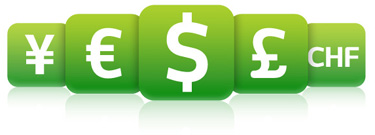
Reading currency prices or exchange rates in the Forex market is easy if you understand a few things.
In the section on trading basics, I discussed simple pricing concepts such as of bid and ask. Do these concepts still apply to currency trading? The answer is “yes.” Let’s see how this works.
The price of a currency (also known as a foreign exchange rate) is always given in terms of another currency. That is why you will hear that currencies trade in “pairs.”
In the Interbank market, the order of the currency pairs is standardized; for example, euros in terms of dollars, dollars in terms of Japanese Yen, and not the other way around. An example can make this clearer.
Ex: Reading Euro Prices – Base/Quote Currency
Let’s say that the price of the euro versus the dollar is shown as:
EUR/USD = 1.2125
This means (reading from left to right) that 1 euro is equal to 1.2125 US Dollars. The currency to the left of the forward slash (“/”) is called the “base currency” and the one on the right is called the “quote currency” (also called the “counter currency”).
Currency quotes are thus given for the base currency in terms of the quote currency; that is., euros in terms of dollars – 1 euro is equal to 1.2125 dollars. Day traders new to Forex might be confused trying to interpret the quote above mathematically; in other words, thinking that EUR/USD means euros per dollar (it does not – it actually means dollars per euro!!!).
This is a mistake that is quickly avoided when you simply memorize to add a one (1) in front of the EUR/USD and understand that the number on the right (1.2125), beside the second currency, is the number of units of the second currency; in other words, the euro quote EUR/USD = 1.2125 means that 1 EUR is equal to 1.2125 USD.
So to summarize, if a forward slash (“/”) is used to display a currency price, it is merely being used as a separator and not as it would in mathematical notation. That is why many trading platforms do away with the separator altogether and instead, display the two (2) three-letter symbols that make up the currency pairs adjacent to one another; for example, EURUSD instead of EUR/USD (the trading simulator platform that you can request from any page of my site also avoids the use of the forward slash separator).
Memorize this before you start trading currencies, and you will never have another problem interpreting the exchange rate again.
Why Do Exchange Rates Need 4 Decimals?!?
Some of the traders entering the world of Forex for the first time may have an issue with the number decimal places used to quote prices. Why, you may ask, is the quote not simply EUR/USD = 1.21; in other words, why not simplify matters and take the quote to the cent level (two decimal places) and not to the thousandth of a cent level (four decimal places)? After all, we don’t deal with fractions of a cent in real life, do we?
The reason is that currencies are traded in pretty large chunks and a move of a fraction of a cent can represent a sizable amount for many currency pairs. I will discuss this further later.
There are a few exceptions to prices with four decimal places; for example, the quote of the dollar versus the yen uses only to two decimal places. Let’s see what this means?
USD/JPY = 107.65
This means that (reading from left to right like you already learned) 1 USD is equal to 107.65 JPY (Japanese Yen). Pretty simple, right?
See live exchange rates and practice trading currencies by requesting a demo of the live simulator in this section.
Back: Main Section | Next: Pips not Ticks

